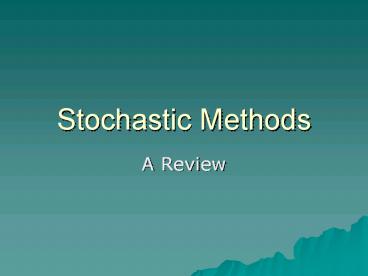Stochastic Methods - PowerPoint PPT Presentation
1 / 17
Title:
Stochastic Methods
Description:
Problem Areas. Diagnostic reasoning. Natural language understanding. ... Pascal. Developed probabilistic techniques to develop a mathematical foundation for gambling. – PowerPoint PPT presentation
Number of Views:90
Avg rating:3.0/5.0
Title: Stochastic Methods
1
Stochastic Methods
- A Review
2
Relationship between Heuristic and Stochastic
Methods
- Heuristic and stochastic methods useful where
- Problem does not have an exact solution
- Full state space is too costly to search
- In addition, stochastic methods are useful when
- One samples an information base
- Causal models are learned from the data
3
Problem Areas
- Diagnostic reasoning
- Natural language understanding
- Planning and scheduling
- Learning
4
Pascal Laplace
- Developed probabalistic techniques to develop a
mathematical foundation for gambling - You might remember that Pascal abjured
mathematics when in 1657 his niece was cured of a
painful infection while being in the proximity of
nuns who kissed a thorn from Christs crown.
5
Sets
- Cardinality
- Number of elements in a set
- For a set A, its cardinality is denoted A
- Universe
- The domain of interest
- Denoted U
- Complement of a set A
- The set of all elements from U that are not part
of A - Denoted
- Subset
- Set B is a subset of set A if every element of A
is also a an element of B - Denoted
- Union
- The union of sets of A and B is the set of all
elements of either set - Denoted
- Intersetcion
- The intersection of sets A and B is the set of
all elements that are elements of both sets - Denoted
6
Rules for Sets
- Addition rule
- Cartesian Product
- Multiplication Principle
7
Permutations and Combinations
- Permutation of elements in a set is an arranged
sequence of elements in that set - The permutation of n elements taken r at a time,
duplicates not allowed - nPr n!/(n-r)!
- The permutation of n objects taken r at a time,
duplicates allowed - nr
- Combination of a set of n elements is any subset
that can be formed - The combination of n elements taken r at a time
- nCr n!/((n-r)! r!)
8
Elements of Probability Theory
- Elementary Event
- An occurrence that cannot be made up of other
events - Event, E
- Set of elementary events
- Sample Space, S
- The set of all possible outcomes of an event E
- Probability, p
- The ratio of the cardinality of E to that of S
- p(E) E / S and
9
Union
10
Intersection and Conditional Probability
- Suppose we have the following tulip table,
telling us whether the tulip bulbs we have are
red or yellow and bloom late or early - Early(E) Late(L) Totals
- Red (R) 5 8 13
- Yellow (y) 3 4 7
- Totals 8 12 20
11
- If one bulb is selected at random, the
probability that the bulb will be red is P(R)
13/20 - Now, we want to know the probability of grabbing
a red bulb given that it is early. - P(RE) 5/8 R E/E
- (R E/S) / (E/S)
- P(R E)/P(E)
12
Conditional Probability
- Definition
- For any two events, with p(B) gt 0, the
conditional probability of A given that B has
occurred is - P(AB) P(A B)/P(B)
13
Independence
- Definition
- Two events A and B are independent if p(AB)
p(A) - The second piece follows
- p(BA) p(A B)/p(A) (def. of cond.prob)
- p(AB) p(B)/p(A)
- p(B)
14
Theorem
- A and B are independent if and only if
- P(A B) p(A) p(B)
- Proof (left to right)
- Since p(A B) p(AB) p(B) and since A and
B are independent - P(A B) p(A) p(B)
- Proof (right to left)
- Since p(A B) p(A) p(B)
- And p(A B) p(AB) p(B)
- Then P(A) p(AB) so A and B meet the definition
of independence
15
Example 1
- What is the probability of rolling a 7 or an 11
using two fair dice? - Sample space is the cardinality of the cartesian
product of the set of values from each die
namely, 36 - The subset of the cartesian product that can
produce 7 is - A (1,6),(2,5),(3,4),(4,3),(5,2),(6,1)
- The subset of the cartesian product that can
produce 11 is - B (5,6),(6,5)
- E A B
- p(E)8/36 .2222
- Another way is to use the probability of the
union of sets - P(A U B) p(A) p(B) p(A B) 6/36 8/36
0 - .2222
16
Example 2
- What is the probability of being dealt a
four-of-a-kind hand in a five card poker hand? - S is the set of all five card hands. So,
- S 52C5 2,598,960
- E is the set of all four-of-a-kind hands
- T is the set of card types
- W is the set of all ways to pick four cards of
the same type - R is the set of all remaining cards
- So
- E T W R
- E 13C1 4C4 48C1 13 1 48 624
- So, p(E) E/S .00024
17
Example 3
- Recall that two events are independent if and
only - Consider a situation where bit strings of length
4 are randomly generated. - Let A the event of the bit strings containing
an even number of 1s. - Let B the event of the bit strings ending in 0.
- Are A and B independent?
- S 24 16
- A 1111,1100,1010,1001,0110,0101,0011,0000
- A 8
- B 1110,1100,1010,1000,0010,0100,0110,0000
- B 8
- P(A B) A B/S 4/16 .25
- P(A) p(B) 8/16 8/16
- So A and B are independent































